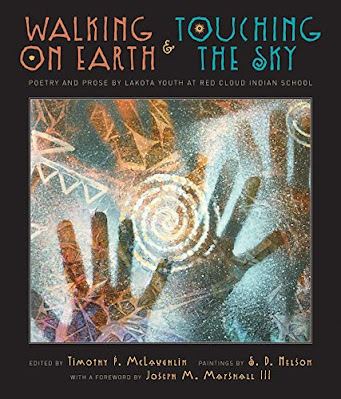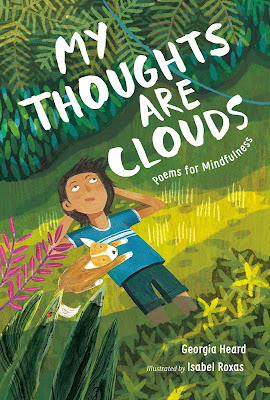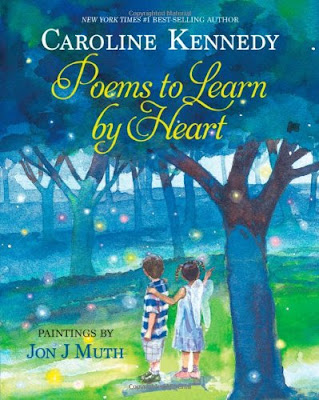Walking on Earth and Touching the Sky
Bibliography:
McLaughlin, Timothy P., and Joseph Marshall III. Walking on Earth and Touching the Sky: Poetry and Prose by Lakota Youth at Red Cloud Indian School. Ill. by S.D. Nelson. New York: Harry N Abrams, 2012. ISBN: 978-1419701795
Summary:
Walking on Earth and Touching the Sky is a sincere and moving collection of poetry and prose written by the Lakota youth at the Red Cloud Indian School on the Pine Ridge Indian Reservation in South Dakota. In short passages, the young writers explore their cultural heritage and the misery and resilience of Native people in modern times. A foreword by Joseph M. Marshall III (Sicangu Lakota) acknowledges the importance of listening to young voices, reminding us that no image of life is complete without the perspective of the young. The voices expressed in this book represent the legacy of the Lakota people, carried by children into the future. These children and teenagers share their experiences of life on the reservation, including a deep reverence for nature and family as well as the struggles of poverty, racism, addiction, and loss. “They speak with an unblinking, honest humanity that serves as an example for anyone who wishes to stand up and be heard.” Five sections arranged by theme explore the values and thoughts most vital to their experience and culture: Natural World; Misery; Native Thoughts; Silence; Spirit; Family, Youth, and Dreams; and Language. Introductions to each section feature original paintings by S.D. Nelson with sacred imagery and poetic captions that express deep truths from the Lakota tradition. Each section also begins with an introduction by the editor and teacher Timothy P. McLaughlin who provides readers with background on the culture, themes, and writing experiences of the young writers. The collection concludes with an author’s note and an index of titles and poets.
Analysis:
In the foreword to this beautiful and sometimes heartbreaking collection, Joseph M. Marshall III writes, “Though they may speak with youthful innocence, they also speak, because of that innocence, from the unvarnished reality of their place in the world. They are learning that a reservation is not only a homeland, it is also a proving ground. For that reason, at the very least, we should listen to them.” From the outset, readers will sense the special perspective contained in the pages of this book. The Red Cloud Indian School, formerly the Holy Rosary mission formed in 1888, began as a force for assimilation and evolved into a site of cultural preservation. The Lakota youth speak from multilayered identities, belonging both to their Native culture as well as the broader, modern society. From this vantage point, they speak with profound wisdom and insight.
Poetic devices such as personification occur naturally in the writings, an expression of reverence and kinship with the natural world that comes from their spiritual heritage. In the poem “What the Roses Are Saying,” Dena Colhoff writes, “What the roses are saying cannot be heard through voice / but through beauty as you watch the rain slip / from their petals and hang from their edges.” Derrick McCauley writes, “The sky is my mom watching over me. / The water is my memories to be. / Nature is my home and family.” These simple phrases express a deep personal connection to the land, and readers will sense the writers’ pride and love for the natural world. A particularly heartbreaking prose poem by Larissa Ross explores her conversation with Mother Nature. “She cries and asks me, ‘How?’ She continued, ‘It’s gone. I had to say good-bye to my grass, trees, and little animals, too. This was once beautiful and I was happy, but now I feel like you.’”
Misery is a common theme, enough to merit its own section. Because modern Native people living on reservations experience disproportionately high rates of poverty, alcoholism, and depression, the young writers express themselves with raw urgency and honesty. J.J. Wilson writes, “Misery is when you watch TV and see all the cowboys killing all the Indians. Misery is when people think Indians scalp everyone. Misery is going to a place, and everyone watches every move you make.” The deep sense of mourning and loss is tangible. Kayla Matthews describes getting dressed in black every day to go to another funeral for a friend who has died from alcohol poisoning or overdose. In one poignant simile, Julian Bear Runner writes, “Racism is like a gun in a child’s hands / loaded with all the words a devil would say.”
Despite the very real pain of loss experienced by these young writers, there is also a profound sense of strength and pride in the Lakota traditions and identity. S.D. Nelson’s vibrant and spiritual paintings depict traditional ceremonies such as the Fire Chant where Lakota people gather around the fire, some in traditional animal skins and paint, others in baseball caps and glasses, drumming and chanting together under the swirling cosmos above. The caption by the artist appearing beneath the painting reads, “Come coyote brothers. Together we will sing up the stars. Yes, we will sing up the moon. -- Humans have known and used fire for ages. I believe our psyche is imprinted with the memory of gazing into the mesmerizing glow of fires from long ago. Like our ancestors, we still gather in the firelight to sing old songs.”
Walking on Earth and Touching the Sky is an important collection of voices that represent the living legacy of the Lakota people from the perspective of the young. Readers will be inspired to learn more about Native cultures and will be moved to grapple with the realities of the challenges and injustices indigenous people continue to face today. A profound work of humanity and spirituality. Ages 8-12.
Excerpt:
I am a rose in a patch of weeds.
I am a storybook mixed in with some dictionaries.
I am a chokecherry bush surrounded by oak trees.
I am a window that is broken.
I am a boy with lots of sisters.
I am an Indian surrounded by white people.
I am a football player at a basketball game.
I am a cat with a bunch of dogs.
I am an angel around a lot of devils.
I am a Walkman at a rock concert.
I am a block that tries to fit into a circle.
-Dusty Black Elk
Activities:
- Read the poem above aloud with readers and invite them to create their own “I Am” poems with a list of metaphors that express something true about themselves.
- Read poems from the section “Natural World” and invite readers to use personification to describe elements of nature with reverence as beloved family members.
- Explore other Indigenous voices such as Joy Harjo and Joseph Bruchac.
- Hire an Indigenous storyteller to visit your library for a memorable cultural experience.




Comments
Post a Comment